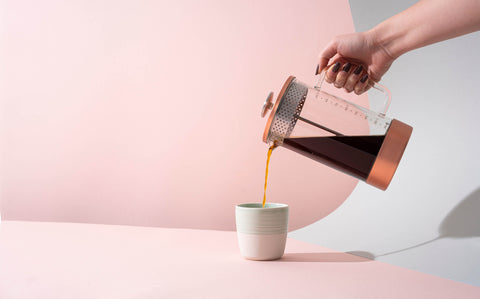Time machine took us somewhere around 2025. Do we still crave our morning coffee for a kick of energy? Is a cup of Joe in our favourite coffee shop still a thing or do we only press the button of the automatic coffee machine in our kitchen? Do we even leave home anymore? What’s the future of speciality coffee commerce? Coffeedesk, the leading coffee and coffee accessories eCommerce in Europe, helps us find answers to all those questions.
Written by Aga Bukowska for Standart in collaboration with Coffeedesk.
Studies consistently show that the global pandemic has seen accelerated growth in eCommerce. According to Forbes and Adobe, attaining the levels of growth that eCommerce has seen during the pandemic would have taken 4–6 years based on pre-pandemic trends. IBM’s U.S. Retail Index that responses to the pandemic have accelerated a shift away from physical stores to digital shopping by roughly 5 years. What does this mean? Simply, it means we have to adapt, and adapt quickly.
Suddenly we find ourselves in a new reality in which consumers have begun shopping online much more frequently and stores on High Streets and in shopping centres are seeing significant declines in trade. Naturally, shoppers are avoiding direct contact, a facet of shopping especially important throughout the specialty coffee community. Retail shopping is down, with ‘non-essential’ stores closed in many regions. But, as we all know, coffee is an essential, and promisingly, purchases of coffee equipment have risen by 11% (SCA).
What do we find in this brave new world?
Opportunity, that’s certain. eCommerce is skyrocketing, and coffee is among the top sellers, boasting a 38.6% CAGR (Compound Annual Growth Rate), claimed Kathy Cummins, head of analytics at Hinge Global during The Impact of Covid-19 on Coffee eCommerce webinar. The CAGR for the total US coffee industry is estimated to be 4.8%, so the difference is tremendous.
The Coffeedesk cat predicts the following trends from her crystal ball (and we confirm them with data):
- The rise of home coffee consumption
- Manual brew popularization
- Curiosity, spare time and education
- Sustainable and green consumerism
- Coffee subscription service rise
- Omnipresent omnichannel
Home barista

Up to March 2020, out-of-home coffee consumption, in cafés and restaurants, made up around 25% of total consumer demand for coffee. 95% of these businesses closed temporarily or permanently in early 2020, so the coffee industry took a big hit. But even with favourite coffee shops, restaurants and offices closed, people did not stop drinking coffee on a daily basis. They just started to prepare it at home.
'We can see clearly that the demand for coffee does not drop at all, it constantly grows with new types of clients and generation Z entering the market. The only factor that changes is the structure of sales, distribution points. There are various types of fluctuations, at one point the number of orders in gastronomy decreases and the number of home orders increases, we also observe reduced coffee consumption in offices, but growing interest of individual customers.
To sum up, regardless of the situation and place we are in, our desire for a cup of coffee does not change, we do not want to give it up. Coffee stands above the divisions: age, ideological and professional. People who start their day, regardless of the type of activity they perform, wealth and latitude, have one thing in common - a cup of coffee in their hand.'
- Łukasz Wichłacz, Chief Everything Officer, Coffeedesk
When many of us started working from home, we began to feel uncomfortable going out to buy a cup of coffee. But it did not change our basic need for that energy kick. We may give up on fancy clothes, sports, cars, everything, but coffee? Never. Here comes a superhero of the lockdown – the home barista.
Coffee drinkers have now more space and time for repeating and refining their recipes. Moreover, they want their morning rituals back, they miss the vibes of their beloved coffee spots and they look for other ways to start their day with a smile and the smell of freshly ground coffee. They try to recreate the quality of the beverages they used to enjoy in cafés. The speciality coffee market comes to the rescue with drippers, manual grinders, and other accessories that are incomparably cheaper than coffee machines. Manual brewing gains popularity in households because of the low entry level and stays there because of the unique experience and taste. According to Perfect Daily Grind’s research, many people claimed that they are using the same equipment and coffee products as before the pandemic, but it’s also evident that they are eager to try new things. Over 40% of millennials stated that they have experimented with different brewing methods.
We have also seen an increase in coffee bean sales. Around one in four people in the US reported stockpiling coffee to avoid running out, according to Perfect Daily Grind. Coffeedesk observed a similar situation last year. In this case stockpiling did not mean, as it usually does, a drop in sales after stocking. Rather, the phenomenon has smoothly turned into greater consumption of coffee beans. Compared to 2019, the speciality beans category grew 89%. The non-speciality beans category was up only by 29% over the same period. A very interesting trend is the growing popularity of decaf. Non-caffeinated beans grew 65% the largest year-on-year increase in history.
Curiosity, time, and education
Consumers are becoming more and more curious; they want to perfect their recipes and techniques. They watch videos, read articles, and find many other ways of deepening their coffee knowledge. Coffeedesk, during the first lockdown ran a series of live videos with Maciej Duszak, the Polish Brewers Champion and Coffeedesk’s Master of Coffee Science, which enjoyed a lot of popularity. People were brewing coffee the same way at the same time; it created a little substitute for the coffee community that everyone missed so badly. Coffeedesk have also created a lot of coffee content on the Coffeedesk blog and their coffee support Facebook group was on fire—filled with questions, recipes, advice, and more.
People finally have time to read books and specialized magazines, watch videos about coffee, and find out where their coffee really comes from. This deeper knowledge may push consumers in the direction of more ethical, transparent, and sustainable coffee-purchasing practices. It’s a great opportunity for speciality coffee.
Sustainable, purpose-driven companies

2020 saw a shift away from environmental matters to matters of health, but in 2021 we will put the spotlight on sustainability once again. Consumers will expect their favourite brands to change their business models, introduce sustainable packaging solutions, eliminate plastics, and introduce refillable/reusable packaging options for as many products as possible. Deloitte research also claims that purpose-driven companies are likely better positioned to ride out this time of extraordinary change—they know why they exist and who they’re built to serve, regardless of what they sell today. That spells a big opportunity for speciality coffee, a market based on community, knowledge of provenance, and common purpose.
Corporate sustainability initiatives have already become mainstream, with, for example, Starbucks’ CAFÉ Practices and Nestle’s Nespresso AAA programmes. Based on the sourcing commitments of the 10 largest coffee roasting companies, an additional 0.3 million metric tonnes of sustainable coffee could be sourced by 2025. The leading buyers’ sourcing commitments are driven mainly by consumer preferences to purchase more sustainable and healthy products. Green consumerism continues to rise.
Subscription
People want their coffee, and they want it now. There’s nothing worse than running out of beans in the middle of shutdown. Consumers want to secure their coffee supplies and be the heroes in their homes. That leads to the increasing popularity of subscription services. In the USA, the number of roasters offering subscription services during Covid-19 rose by 25% and subscription sales increased by 109%, according to a Square and SCA report. We strongly believe that this trend will continue to grow.

The Hi!Coffeedesk subscription is aimed at providing speciality a coffee shop experience in every home—both for beginners and experienced home baristas. Our collection introduced in January 2021 is based on intuitive sensory profiles, each representing individual taste preferences, such as chocolatey, floral, and citrus. We believe that coffee is all about taste—taste that perfectly matches you.'
- Aneta Rybka, eCommerce Manager, Coffeedesk
Follow your client

Omnichannel shopping will become the new black when it comes to coffee. What does omnichannel mean? It means providing shoppers with a consistent experience across all channels and devices. Wherever they want, whenever they want. In a survey by Harvard Business Review, 73% of respondents said they use multiple channels during their shopping journey. And they were asked this question four years ago, today the percentage would definitely be higher. There are many ways in which omnichannel shopping can define the coffee industry. Just to name a few: we will buy online, pick up in-store (or coffee shop), we will buy in-store (or in a café) and choose home delivery, or the classic way—buy online with doorstep delivery. Most of the buy now buttons will probably be clicked on mobile devices, while watching a movie on a different screen. Omnipresence!
Afterword
With vaccination on the horizon, the shutdown nightmare will soon be over. But will coffee commerce go back to normal? We don’t think so—what we call normal may not exist anymore. People will surely get used to their subscription, they will continue to brew coffee at home, as they already have all the necessary gear. They will probably buy coffee using their smartphones and they will choose retailers that provide good customer service and free delivery.
After almost a year, people also crave socialization (we cannot wait to drink a proper flat white in porcelain while chatting with a friend). We believe that people will continue their morning routines at home and then, for example, head to their favourite coffee shop to connect with friends or family at another time of the day. The knowledge coffee drinkers acquired during the pandemic will stay with them. With a great number of consumers reading online articles, watching videos, investing in brewing equipment, and signing up to coffee subscription services, the understanding of the coffee scene and its supply chain will naturally increase. That awareness, if we take good care of it, can shape the speciality coffee industry and have a great impact on the future of coffee in general. Fingers crossed!
Words by Aga Bukowska and photos by Przemysław Sejwa (Studio Wasabi) and Anna Zielińska (Photoholic Studio). Published by Standart in proud partnership with Coffeedesk.



